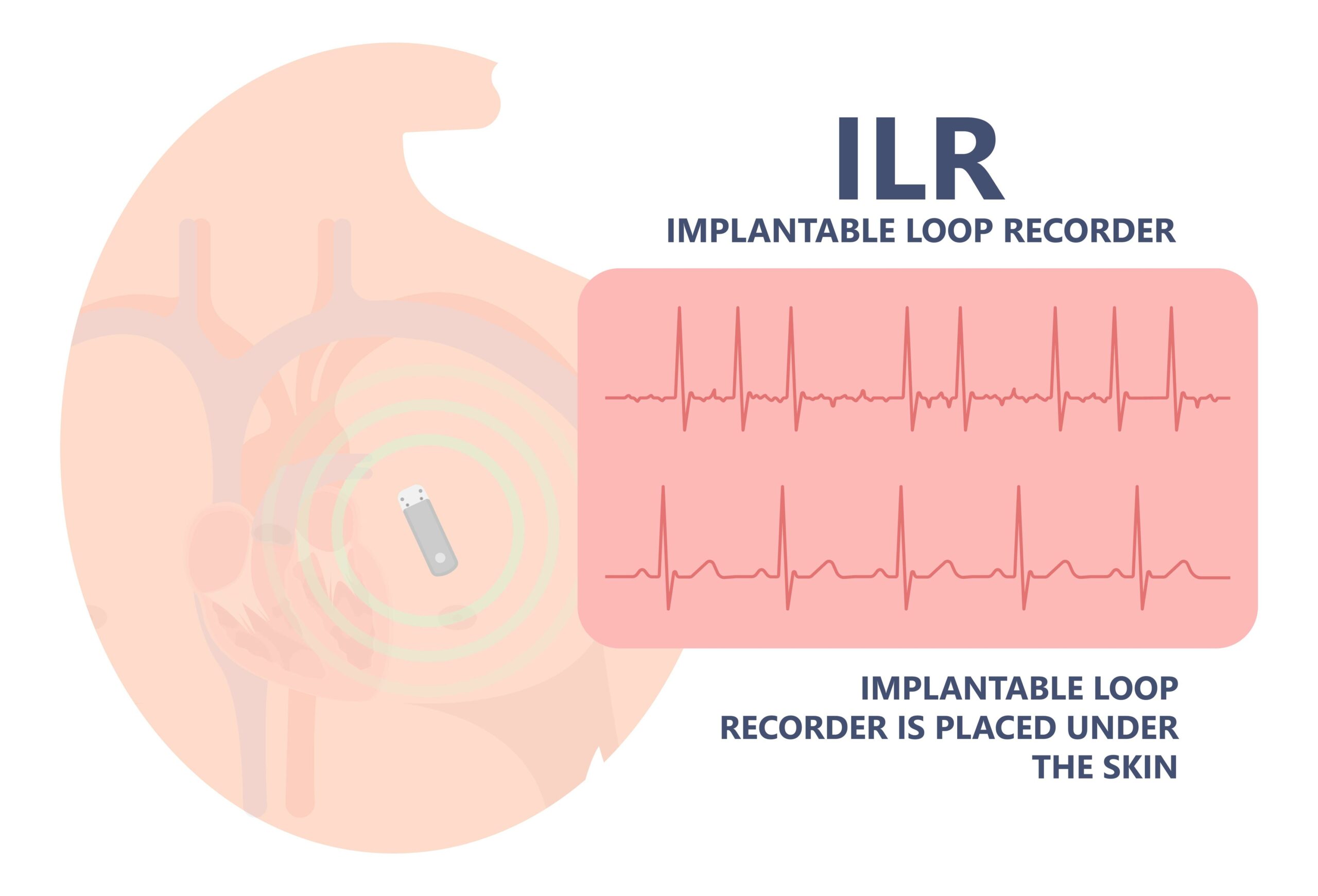Implantable Loop Recorder
Lorem ipsum dolor sit amet, consectetur adipiscing elit.

Why Get An Implantable Loop Recorder
A tiny device called an implantable loop recorder can help monitor your heart rateand rhythm. It is a small deviceabout an inch long and the diameter of a pen, implanted under skin during a simple procedure, taking less than 10 minutes. It is like having a 24/7 heart detective who records your heart’s activity for more than4 years.Once healed, there are no restrictions whatsoever, swimming, exercise, use of any technology any medical testing are all allowed.
You might be wondering why you’d need this monitor. An implantable loop recorder may help your doctor understand fainting spells, heart palpitations, and other heart-related symptomsthat happen infrequently. It is useful because it can catch hard-to-detect heart events that regular checkups or short-term monitoring miss.
Visit your Atlanta CVG cardiologist to learn more about the benefits of an implantable loop recorder. Our heart doctors can determine if this device is right for you and discuss the implantation process with important heart issues that can be scary and confusing. They will conduct tests to discover if an implantable loop recorder or other treatments can help.
You are taking a proactive step by getting tested to see if you need an implantable loop recorder. If you receive one, it is important to your heart health because it lets your doctor watch your heart perform from behind the scenes. Any problems can be detected early and treated right away. An implantable loop recorder can benefit your health now and help protect it for the future.
Please read on for more information on implantable loop recorders and how CVG offers comprehensive cardiac care.
Who Should Get Tested
Loop recorders are usually recommended for patient that have rare fainting episodes or who have suffered an unexplained stroke. This is also an option if other tests have not given any answers as to the cause of your heart issues.
Loop recorders can also be helpful for older people who experience unexplained falls. Doctors may also use the device for people they believe to have epilepsy who have not responded to medicine. In these cases, a cardiac event recorder can help your doctor determine if these issues are due to an abnormal heart rhythm.
How To Prepare
How The Test Works
For the procedure, you will be given medicine to relax and your skin will be numbed with local anesthetic. Your doctor will then make a small incision, about as broad as the pinkie fingernail, on the upper left area of your chest where the device will be inserted. Your doctor will create a small pocket in this area to fit the device, which is about an inch long ans the diameter of a disposable ballpoint , and then place the device into the pocket. After the loop recorder is inside your skin, the incision will be closed with sutures.
As with any other surgical procedure, the loop recorder implantation can have small risks. These risks can include slight bleeding or bruising, an infection which may require removal of the device and mild pain at the site of the incision. Your risks will depend on your age and other medical conditions, so discuss the potential risks of the procedure with your doctor.
Living With The Device
An implantable loop recorder is unnoticeable and does not interfere with your regular activities. There are no patches or wires, so you don’t have to worry about getting the device wet when showering or swimming. A loop recorder is also considered safe for use during MRI testing, though you should still let any doctors know about the device before undergoing any such tests.
There is a chance that your device may set off metal detectors, such as those at airport security, so in these cases your doctor will provide you with a device identification card to carry with you for these situations.
What The Results Mean
Once the device is inserted, you’ll be given a transmitter device to place on your nightstand. This will automatically send the information monthlythe loop recorder collects to your doctor,via the internet, while you sleep. You can also push a button to manually send the data as soon as you experience any symptoms. Your doctor may also ask you to keep a log of any symptoms you experience and when they occur.
Your doctor will interpret the results of the data and call you if they have any cause for concern. While the device is in place, it is recommended that you see your doctor once a year for routine checkups.
Why Choose CVG?
Related Conditions:
- Causes And Treatment For Heart Arrhythmia
- Causes And Treatment Of Pulmonary Stenosis
- Expert Insights on Cardiac Catheterization
- Expert Insights on Low Blood Pressure
- Exploring the Latest Advances in Atrial Fibrillation Treatment
- Dangerously high cholesterol?
- Get Your Blood Pressure Test Today!
- Understanding Electrical Cardioversion
- What Are ACE Inhibitors Used For?
- What foods are high in cholesterol?
- What Heart Flutters Can Mean
- What is Heart Failure & How to Treat it?
- What Is The Success Rate Of The Watchman Procedure?
Top Conditions:
- How long can someone live with an enlarged heart?
- Pros and Cons of the Watchman Device
- Risks and Complications of Cardiac Catheterization
- Side Effects Of The Watchman Device
- The Benefits of Cardiac Catheterization
- The Dangers Of High Blood Pressure
- The Dangers Of High Cholesterol
- The Watchman Implant Procedure
- Tips To Lower High Cholesterol
- Understanding Cardiac Catheterization
Call to Schedule an Appointment
Board-certified Doctors
CVG’s twenty board-certified heart doctors will guide you through your healthcare journey with the utmost compassion and individual attention. We aim to provide you with state-of-the-art cardiac care that includes the full spectrum of services, from testing to diagnosis and treatment. The doctor/patient relationship is built on trust. Through our combined efforts, we can conquer any challenge that comes our way.
Invasive therapies may also treat an abnormal heart rhythm, such as electrical cardioversion, which sends electrical impulses through your chest wall and allows normal heart rhythm to restart, or catheter ablation that disconnects the abnormal rhythm’s pathway. Suppose your doctor determines that electrical devices are the best course of action. In that case, you may be given a permanent pacemaker, an implantable cardioverter-defibrillator (ICD), or biventricular (B-V) pacemakers and defibrillators.
How CVG Can Help
CVG offers multiple services that can discover an enlarged heart or conditions that will lead to it. At CVG, we perform stress tests that will observe blood flow and test for various forms of heart disease. There are three types of stress tests that we perform:
- A treadmill test is a test in which you will walk on a treadmill that gets faster and steeper every 3 minutes. This will stress your heart so that our nurse or doctor can determine your heart rate and blood pressure.
- An echo test is performed before and after your treadmill test to determine how well your heart pumps blood.
- A nuclear stress test is a treadmill test that is prefaced by an injection of medicine that shows the flow of blood to your heart.
We also offer cardiac catheterization to diagnose and treat several heart issues. If any of these tests determine a problem, we offer treatment solutions such as atrial fibrillation testing and catheter ablation. Learn more about our services here, or schedule an appointment to talk to our doctors.
Schedule Your Appointment with a CVG Atlanta Area Cardiologist
Expertise, experience, and compassion are the pillars of CVG’s patient-centered cardiac care. Please schedule your appointment with CVG today. Call (770) 962-0399 or 678-582-8586. You may also request an appointment online. If you have an emergency, don’t contact us online; please call 911.
Locations That Treat Implantable Loop Recorder












